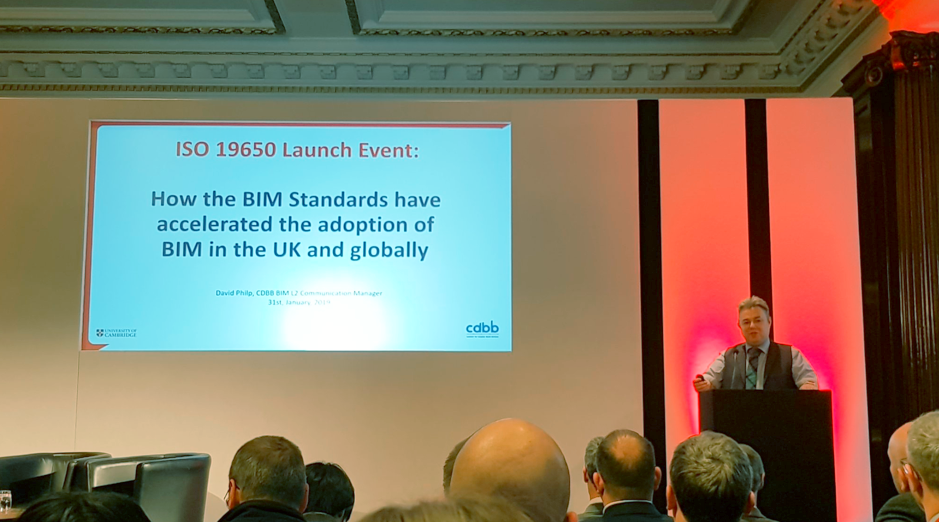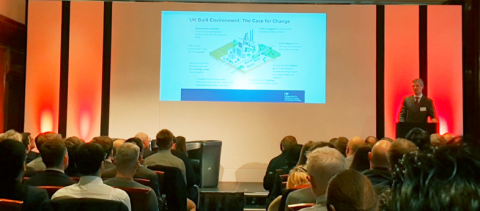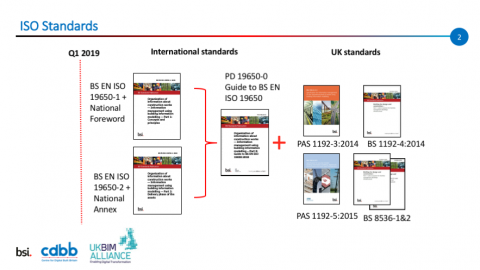
Submitted by Angela Walters on Mon, 04/02/2019 - 10:35
The Centre for Digital Built Britain [CDBB] was delighted to support the British Standards Institution [BSI] launch event and celebration of the recently published BS EN ISO 19650 Documents, National Annex and Transition guidance held at the Institute of Civil Engineering [ICE] on 31 January 2019, in conjunction with the UK BIM Alliance.
Celebrating the publication ISO 19650
Anthony Burd - Head of Sector, Built Environment, BSI opened the event. In his talk celebrating the ISO publication, Scott Steedman - Director of Standards, BSI, commented that the PAS 1192 series of standards have had 150,000 plus downloads, 20% from outside of the UK. Scott introduced the ISO launch as an example of industry coming together and delivering change – and emphasized that Building Information Modelling (BIM) provides a competitive advantage.
The importance of Digital and UK leadership in the Built Environment
Fergus Harradence - Construction Leadership Council/ Deputy Director for Construction, Department for Business, Energy and Industrial Strategy, delivered a presentation on Digital information management: BIM and the Information Management Framework (IMF)

Fergus Harradence - Construction Leadership Council/ Deputy Director for Construction, Department for Business, Energy and Industrial Strategy
It was noted by Fergus that the construction industry accounts for circa 9% of economic activity in the UK and that the case for change is of huge importance. The adoption of Building Information Modelling (BIM) sits at the heart of the digital transformation across the UK built environment.
Fergus highlighted CDBB’s role in providing a focal point for activity in the UK to develop digital technologies linked to the built environment. Including aa spotlight on the Digital Framework Task Group (DFTG) and a request for feedback to the Gemini Principles report published late last year.
In the question and answer session Fergus suggested that BIM has now become “business process re-engineering.”
How the BIM Standards have accelerated the adoption of BIM in the UK and globally
David Philp - Centre for Digital Built Britain and Home Nations Working Group
David introduced CDBB and how it is working to support the digital transformation of the built environment. It does this by building academic capacity, informing policy, and supporting industry change.
David took us through the history of the BIM programme noting that the transition to international standards was always planned. He explained how the BIM Level 2 standards and principles have given us a solid information management backbone to support this transition. There was an appeal to the audience not to forget other standards in the BIM suite that have not as yet became an international standards (such as PAS1192:3, PAS1192:4 and importantly Soft Landings enabled by BS8536:1&2).
David highlighted how the current standards have helped move the dial for UK industry: enabling the wider adoption of BIM technologies, processes and collaboration by ensuring that the same accurate data can be accessed throughout the supply chain. He commented that UK Standards have helped us galvanise change, raised awareness and steered clients and the supply chain towards better information management and exchange methodologies.
The second session focussed on the new ISO 19650 standards. Dr Anne Kemp - BIM Strategy & Development Director, Atkins, provided the context for the new standards and emphasised the importance of collaboration and how open and effective collaborative working helped with their development. David Churcher - Director, Hitherwood Consulting, highlighted some of the key differences to be aware of, and Paul Shillcock -Director, Operam, gave an overview of the guidance and updates, including the UK Annex.
Together, Anne, David and Paul gave a masterclass in the ISO Transition noting that these two standards are only the first in a series and will likely be followed in 2020 with ISO19650-3 and 5. A lively and valuable question and answer session followed, with helpful advice on how the transition can be managed by individuals and companies.
Anne explained how we need not to just consider the ISO documents and Annex but also the remaining UK standards in the BIM suite as noted below.

David then noted the key changes in ISO19650-1:
- Lifecycle information management
- Revised expression of BIM maturity
- Modular information management process around appointments
- Volume strategy becomes the broader concepts of federation strategy plus container breakdown structure
He commented that these are all founded on the principles established in BS1192:2007 and PAS119:2
Paul then walked us through the ISO19650-2 the information management process during the delivery phase of assets noting the logical pathway it now creates.

He also highlighted the interfaces between parties and teams for the purpose of information management and key term changes in the ISO.
Overall the message was don’t be afraid, BS EN ISO 19650 is simply an internationalisation of the UK’s BIM & contains all the same principles and high-level requirements with specific UK content contained in our National Annex. There is a real opportunity for the UK.
The BIM journey so far: Customers Sharing experiences
In the last session we enjoyed hearing about the BIM experiences, journeys and value being unlocked from Melanie Dawson of Graham Construction and Dr Jamie Dupée of Edocuments.
There followed a drinks reception to celebrate the achievement of reaching international agreement on the standards for managing information over the whole life cycle of a built asset using building information modelling.
